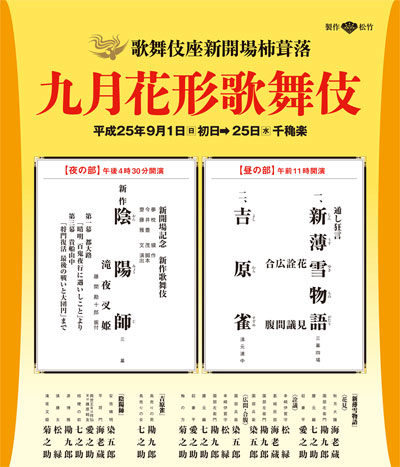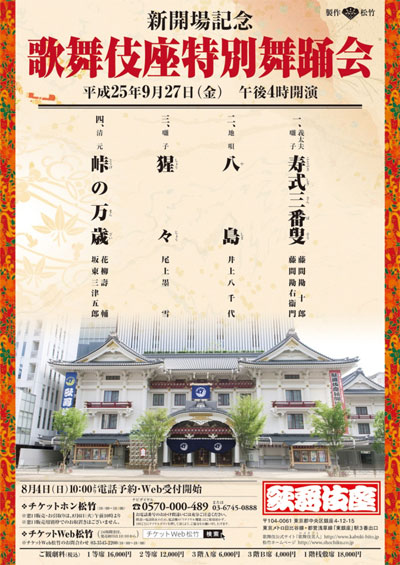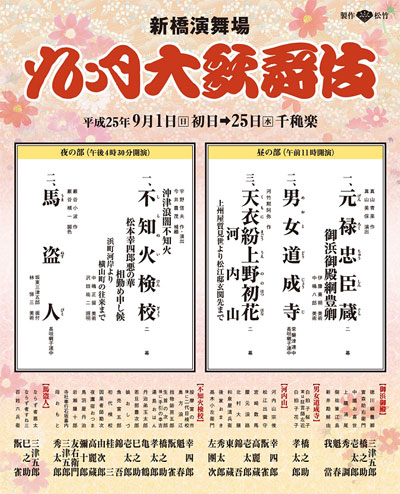| SEPTEMBER 2013 |
|
5 shows in T˘ky˘ (Kabukiza, Shinbashi Enbuj˘), 1 in Fukuoka (Hakataza) and 1 tour (Western Provinces)!
|
| Kabukiza (T˘ky˘) |  |
| Dates | 1 ~ 25 September 2013 (Kokera Otoshi Kugatsu Hanagata Kabuki) Opening Ceremony September Young Actors Kabuki |
| MatinÚe |
|
| Evening |
Onmy˘ji (Takiyashahime) |
| Casting |
Ichikawa Ebiz˘, Onoe Kikunosuke, Kataoka Ainosuke, Nakamura Kankur˘, Ichikawa Somegor˘, Nakamura Shichinosuke, Onoe Sh˘roku, Ichikawa Danz˘, Kawarasaki Gonjűr˘, Ichikawa Unosuke, Ichimura Kakitsu, Kataoka Ichiz˘, Kataoka Kamez˘, Band˘ Kamesabur˘, Band˘ Kametoshi, Nakamura Matsue, Kamimura Kichiya, Nakamura Baishi, Band˘ Shingo |
| Comments |
6th month celebrating the opening of the new Kabukiza within a 1-year long cycle of kokera otoshi programs.
|
 |
| Kabukiza (T˘ky˘) |  |
| Dates | 27 September 2013 (Kabukiza Tokubetsu Buy˘kai) Kabukiza Special Dance Gala |
| Program |
Yashima T˘ge no Manzai |
| Casting |
Fujima Kan'emon, Fujima Kanjűr˘, Hanayagi Jusuke, Onoe Bokusetsu, Inoue Yachiyo |
| Comments |
The first special Buy˘ since the opening of the new Kabukiza in April 2013! |
 |
| Shinbashi Enbuj˘ (T˘ky˘) |
| Dates | 1 ~ 25 September 2013 (Kugatsu ďkabuki) September Grand Kabuki |
| MatinÚe | |
| Evening |
Okitsu Nami Yami no Shiranui (Shiranui Kengy˘) |
| Casting |
Matsumoto K˘shir˘, Nakamura Hashinosuke, Nakamura Kanjaku, Kataoka Takatar˘, Nakamura Kaishun, Kataoka Gat˘, Band˘ Yajűr˘, Kataoka Hidetar˘, Ichikawa Sadanji, ďtani Tomoemon, Nakamura T˘z˘, Nakamura Kikaku, Band˘ Shűch˘, Matsumoto Kingo, Ichikawa Komaz˘, ďtani Keiz˘, Sawamura Yoshijir˘, Band˘ Minosuke, Nakamura Kazutar˘, Sawamura S˘nosuke, ďtani Hirotar˘, ďtani Hiromatsu, Ichimura Takematsu |
| Comments |
|
 |
| Kabuki Tour in the western provinces | |
| Dates | 31 August ~ 25 September 2013 |
| Program | |
| Casting |
Nakamura Kichiemon, Nakamura Shibajaku, Nakamura Karoku, Nakamura Matagor˘, Nakamura Kinnosuke, Nakamura Kash˘, Nakamura Yonekichi, Nakamura Tanenosuke, Nakamura Hayato, Nakamura Kichinosuke |
| Comments |
Nakamura Matagor˘ III and his son Nakamura Kash˘ IV celebrate their shűmei touring in the western provinces!
|
|
|||
| Dates | 5 ~ 29 September 2013 (Band˘ Tamasabur˘ Tokubetsu K˘en) Band˘ Tamasabur˘ Special Performances |
||
| Program |
Amaterasu |
||
| Casting | |||
| Comments |
Living National Treasure Band˘ Tamasabur˘ and the Kod˘ taiko drummers revive "Amaterasu", which was staged for the first time in May 2006 at the Minamiza [more details]. |
||
|
|
| Contact | Main | Top | Updates | Actors | Plays | Playwrights | Programs | Links | FAQ | Glossary | Chronology | Illustrations | Prints | Characters | Derivatives | Theaters | Coming soon | News |
